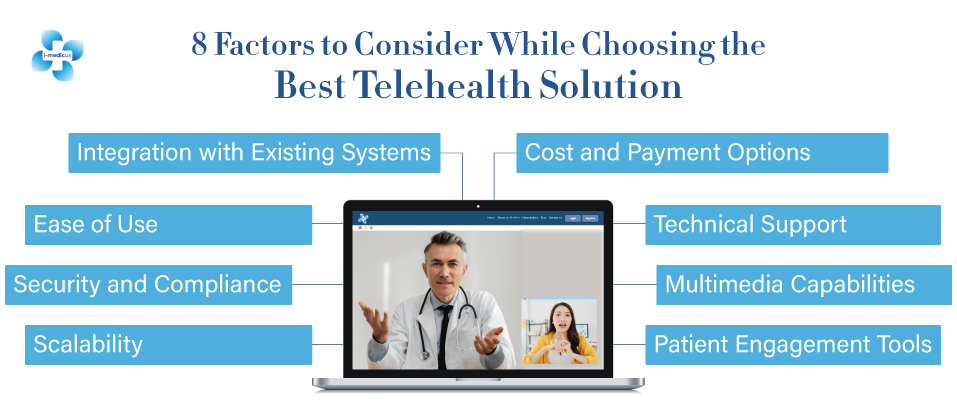Medical practices have been performed for decades, and doctors provide perfect medical cures for patients. However, in the modern science and Healthcare system, the demand for Telehealth apps has become a crucial part of the healthcare industry. The old process of medical practice is overtaken by the latest technologies and tools where doctors and patients can connect remotely from their location via online video consultation. The service has become very useful and helpful for people who cannot visit the doctor in person for certain reasons. So, in that scenario, they can easily find the best doctor for their medical condition online through the top telehealth platform. Without wasting any time, let’s find out the best way to practice a telehealth solution and the factors to consider while choosing a suitable platform.
Demand for Telehealth Services
Extremely high demand for telehealth services has been observed for the following reasons. First, COVID-19 disrupted telehealth by introducing it as a protective means for receiving proper patient care. The following is an example of how healthcare needs were met without half the risk of getting infected with this disease: Due to crowded waiting rooms, many people consulted with doctors online.
Also, the current patient has become more IT-oriented, and healthcare organizations should provide their clients with digital means. They value the ability to access care from their homes, hence no more time wasted and expensive trips. This has been observed to result in enhanced use of telemedicine, hence the need for healthcare providers to embrace this new solution.
Telehealth services also have multiple advantages over other barriers to care, including geographical restrictions and problems with transport. With remote consultation, practices can access clients who otherwise would not be served, expanding the practicing base and general well-being. Therefore, purchasing a good telemedicine solution turns out to be not only advantageous but a fair prerequisite for the modern practice to be successful in the contemporary world.
8 Factors to Consider While Choosing the Best Telehealth Solution

When selecting a telehealth solution, it’s crucial to consider various factors that will impact your practice and patient experience. Here are eight essential considerations:
1. Ease of Use
Accessibility and usability are critical to the success of any telehealth app, patient, and provider. In its simplicity, an intuitive system of operation also reduces the amount of time that most users will spend mastering the various features. If a platform is separate or even complicated and full of numerous options, it discourages patients from engaging in the service and overall experience of their health care.
Furthermore, there should be a simple onboarding process. This paper shows that easy-to-understand instructions, guides, and help can greatly improve user satisfaction and increase usage, which is important for patients using healthcare providers’ services.
2. Integration with Existing Systems
The most important consideration when selecting a telehealth solution involves a telehealth solution that seamlessly integrates with your practice management software, electronic health records (EHR), and billing systems. Smooth data transfer is achieved with effective integration so that there is less risk of error and that patient records remain accurate and up-to-date.
It frees up staff to spend more time on patient care rather than manual data entry. Such a system brings together a cohesive system, and it also helps streamline the workflow as providers have everything they need to make decisions in the same place and interact with patients better.
3. Security and Compliance
In the healthcare industry, patient privacy and data security are a big matter. When choosing telehealth, it is important to consider that you need your telehealth platform to meet HIPAA and other regulations that protect your sensitive patient information.
Check out solutions that include extraordinary encryption methods, safe data storage, and regular updates regarding safety. In addition to that, check whether the provider’s policies on data access and sharing are taking the correct course. A transparent approach to security can demonstrate how your telehealth services are keeping patients’ information safe and can help your service grow in popularity, building trust amongst new patients.
4. Scalability
On Telehealth for Doctors, when you focus more on the needs of patient then it will help you grow demand for the app. Select a platform that can handle an ever-growing number of patients, features, and integrations, and not at the expense of efficiency. A scalable solution ensures that you get added functionality as your patients expand, but the platform still runs smoothly and efficiently.
This flexibility is becoming increasingly important for future-proofing your investment so your practice can and will continue to keep up with changing healthcare demands. It also enables you to scale as you take on new features or services to remain competitive in a rapidly changing healthcare environment.
5. Multimedia Capabilities
A suitable telehealth platform should be capable of using various communication modes, including video, audio, and text messaging. This flexibility enables various consultations according to the requirements and needs of the patients as well the patient’s preferences. For instance, some patients may prefer video consultations for a more personal flare, whereas others may be able to converse using audio calls or messaging.
If you can make sure that the solution that you choose can accommodate these numerous communication styles, you make it easy for patients to interact with healthcare providers. However, this adaptability can translate to better health outcomes and increased patient satisfaction.
6. Technical Support
Reliable technical support is critical when implementing a telehealth solution. Check if the provider has quick, easy access to any appearing problems regarding usage. Troubleshooting technical issues, answering user questions, and helping users with the use of platform features are all included.
Also, look at the size of the comprehensive resources like user guides, FAQs, and online tutorials. Users who have these resources at their disposal can help them get out of common problems independently, which leads to their confidence and satisfaction with the platform being raised. Technical support can be truly exceptional in the end for both patients and healthcare providers.
7. Cost and Payment Options
One of the key aspects to evaluate in your pricing structure is the telehealth solution pricing to ensure that it fits your budget and practice size. Find platforms that have transparent pricing where there are no hidden fees to really know what you are paying each month. Also, think about the payment options for patients; you should expect your solution to support: credit cards, insurance billing, or payment plans, for example.
With flexible payment solutions, you can give flexibility to the patient and better accessibility. In addition, a good pricing model would also assist your practice in conducting and running telehealth services while you are financially stable.
8. Patient Engagement Tools
An effective telehealth solution should have patient engagement features like appointment reminders, surveys, etc. These tools boost patients’ involvement in their care and encourage preventive health management. Appointment reminders reduce no-show rates, and surveys provide feedback to keep services on track.
Educational resources give patients information about their conditions and treatments, helping strengthen the patient/provider relationship. The platform can engage patients, create better health outcomes, and improve patient satisfaction as patients feel more psychologically invested in their care journey.
How to Grow Brand Value Among Patients Worldwide with i-medicus
To establish a strong brand presence and value in the telehealth market, consider leveraging the capabilities of i-medicus. Here are some strategies to enhance your brand value globally:
1. Emphasize Quality Care
Emphasize the way your telehealth practice delivers care. Use testimonials and case studies to showcase successful patient outcomes. Emphasizing high standards can give potential patients a sense of trust and credibility.
2. Promote Accessibility
Present how i-medicus enables the accessibility of care to patients around the globe. Emphasize the important features of multilingual support, flexible appointment scheduling, and remote consultations. Promoting accessibility makes your brand appear as a solution to patients with geographic or logistical challenges.
3. Utilize Social Media and Online Marketing
Utilize social media channels and online marketing strategies to grow your target audience. Share valuable content about telehealth, patient education, and health tips. Interact with your audience through interactive posts, live Q&As, webinars, panels, or live events to build a community around your brand.
4. Focus on Continuous Improvement
Regular updates and improvements demonstrate your commitment to better patient care and a better user experience. Make use of the feedback from patients and providers to make decisions regarding platform improvements. Building on your ability to respond to the needs of your users can build brand loyalty.
5. Engage in Partnerships and Collaborations
Partner with other healthcare providers, organizations, and influencers to expand your reach and strengthen your brand visibility. Partnerships can help you build credibility and increase your resources for your patients. Make sure your marketing efforts highlight these collaborations to show that you’re a company that cares about quality care.
Conclusion
The decision to choose the right telehealth solution for your practice is critical, and it can greatly influence patient care and your practice efficiency. As you contemplate what’s on the market, factors like ease of use, integration, security, and scalability help you choose the right fit with the goals of your practice. Additionally, i-medicus capabilities can expand the brand value for your patients worldwide. In this ever-changing healthcare environment, the changing face of telehealth means that your practice must stay ahead of the curve to stay at the top.
FAQs
Q1 What is telehealth, and how does it work?
Telehealth is the delivery of healthcare services through digital communication technologies, allowing patients to consult with healthcare providers remotely. It works through video calls, phone calls, and messaging, enabling convenient access to care.
Q2 Is telehealth secure for patient information?
Yes, reputable telehealth solutions comply with regulations like HIPAA and implement strong security measures to protect patient information, including encryption and secure data storage.
Q3 Can telehealth be used for all types of medical consultations?
While telehealth is effective for many consultations, some situations may require in-person visits. Assessing each patient’s needs to determine the appropriate mode of care is essential.
Q4 How can telehealth improve patient outcomes?
Telehealth enhances access to care, improves patient engagement, and allows for timely interventions, leading to better health outcomes and increased patient satisfaction.
Q5 What should I look for in a telehealth solution?
Key factors to consider include ease of use, integration with existing systems, security, scalability, multimedia capabilities, technical support, cost, and patient engagement tools.








